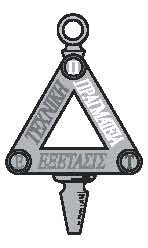JOTS v37n2 - Toward a Zero Energy Home: Applying Swiss Building Practices/Attitudes to U.S. Residential Construction
Toward a Zero Energy Home: Applying Swiss Building Practices/Attitudes to U.S. Residential Construction
Daphene C. Koch, William J. Hutzel, Jason M. Kutch and Eric A. Holt
Abstract
This project evaluated typical U.S. and Swiss homes to identify construction practices that are most energy efficient and have economic payback. A net zero energy home (ZEH) produces as much energy as is consumed in it over time. Students in a College of Technology in a Midwest Indiana State University and a technical University in Switzerland resulted in developing models of homes that combined U.S. and Swiss standards. The project was completed in two phases: during the first phase of this project, construction costs, energy use, and economic payback was calculated for six homes that were designed using both Swiss and U.S. standards. During the second phase of the project, cultural norms that influence energy use were explored. A survey was used to compare U.S. and Swiss college students’ lifestyles and energy habits. All homes had the same basic size and layout, but some used construction practices typical for the United States and others were designed according to Swiss guidelines for residential construction. The results of the study showed that a Swiss-style low-energy home is not cost effective for the Midwestern United States if energy costs remain low, but it could become attractive if energy rates escalate significantly. It was also recognized that technology by itself will not minimize energy consumption, a result of the second part of the project that explored cultural norms that influence energy use. From the survey of both U.S. and Swiss college students’ lifestyles and energy habits, it was revealed with a high level of confidence that Swiss students are more energy conscious than their U.S. counterparts.
Introduction
This project evaluated typical U.S. and Swiss residential design to identify construction practices that are most energy efficient. The analysis reviewed current best practices in both countries along with an evaluation of attitudes toward energy use by individuals. In the United States an Energy Star system is being used to model homes. Energy Star is an umbrella of voluntary programs started in 1992, which ran as a joint program since 1996 with the U.S. Environmental Protection Agency (EPA) and the DOE to improve energy efficiency of homes ( Banerjee & Solomon, 2003 ). The Swiss method of building a sustainable home is the Minergie System ( Minergie, 2010 ). Zero Energy Homes (ZEH) have been built in Japan, Sweden, Germany, Norway, Austria, and the United States. Unfortunately, there is no real database to centralize information to globalize the adoption of successful homes worldwide ( Charron & Athientitis, 2005 ). To add to the existing body of knowledge, this project reviewed the importance of moving toward ZEH homes, and the current practices and attitudes of the United States and Switzerland toward energy efficiency. The research modeled six variations of designs that incorporated the Energy Star and Minergie systems.
Significance of Energy Consumption
The International Energy Outlook (IEO) report projects that the world energy consumption is expected to expand by 50% in 2030 ( Energy Star, 2010 ). Residential buildings account for 22% of the primary energy use according to the Energy Information Administration (EIA, 2008). Within residential buildings, space heating and water heating (both natural gas and electric) are the biggest opportunities for energy savings. Figure 1 details the exact usage of electricity in the home. It shows that most energy is used for heating (home and water), lighting, and cooling. These should be the initial targets to better design a home.
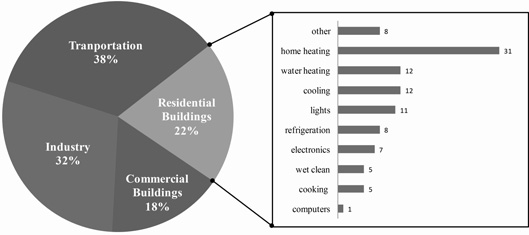
The Department of Energy (DOE) started a program, “Build America,” with a goal of reducing whole-house energy use for new home by 50% by 2015 and 95% by 2025 ( Anderson & Horowitz, 2006 ). The Build America initiative targets significant improvements to the building envelope (the makeup of the walls, roof, and floor) through better insulation and sealants, and major reductions in electricity through using highly efficient appliances, lighting, and mechanical systems. The remaining energy for achieving net-zero will be supplied by a renewable energy source, such as solar or wind.
Residential Construction Standards in the United States and Switzerland
A detailed inspection of the Swiss and U.S. homes showed fundamental differences in construction techniques. Figure 2 shows photos taken by the students to document the typical systems used in each country. The Swiss building standards are more similar to U.S. commercial standards of building with heavy use of a thick masonry brick-type component. This creates more thermal mass than the typical U.S.-style wood-frame home. Significant attention in optimizing the building envelope in terms of insulation, air sealant, and efficient windows is a component of the Swiss system. The highly efficient mechanical systems included air-to-air heat recovery, radiant slab heating and cooling, and solar domestic hot water in Swiss homes, which is currently utilized in more commercial applications in the United States.
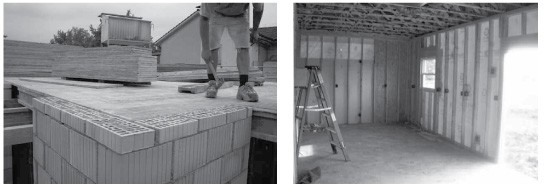
(photos by authors)
Typical Swiss home are built using a masonry type of material, which does not exist in the United States. A Swiss home also typically costs more than $600,000 (U.S.) to purchase, and in Switzerland, most people do not own homes, but rather inherit them. The U.S. has produced affordable housing using wood-frame construction. This vast difference in materials used for homes resulted in the development of a typical midrange U.S. home layout that was developed to be used for modeling the standards of Minergie and Energy Star. Figure 3 shows the standard home layout that was developed to standardize comparisons of different characteristics of homes.
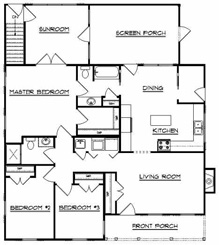
A single-family home with one story and a conditioned unfinished basement was used because this type of construction is found in both countries. The floor plan included three bedrooms, two bathrooms, one walk-in closet, a living room, a dining room, a kitchen, a sunroom, a screened-in porch, and a front porch: it totaled 1,504 ft2 (139.7m2). Four exterior doors account for approximately 100 ft2 (9.3 m2) of surface area and the windows equaled approximately 237 ft2 (22 m2); the majority of the windows face south, which provides additional heating during the winter. The above-grade wall surface area is approximately 1400 ft2 (130 m2).
The basis of the project was to differentiate the Energy Star and Minergie building standards, but it was found that in the United States not all of the Swiss standards were realistically applied. Table 1 identifies six different combinations of residential construction identifying the wall and attic insulation, heating, and application of solar hot water heating. These are the major characteristics of the home that were modeled to evaluate using the standardized floor plan. The combinations range from the least energy efficient design, standard U.S. home, to the standard Minergie home of Switzerland.
| Construction Category | Wall R-value (R SI ) | Attic R-value (R SI ) | Heating | Solar for Hot Water |
|---|---|---|---|---|
| Standard U.S. | 11 (1.94) | 30 (5.28) |
Gas - 80% AFUE
80 MBtuh (23.4 kW) |
No |
| Energy Star | 19 (3.35) | 50 (8.81) |
Gas - 92% AFUE
80 MBtuh (23.4 kW) |
No |
| Standard Swiss | 19 (3.35) | 38 (6.69) |
GSHP - 5.0 COP
40 MBtuh (11.7 kW) |
No |
| Minergie | 30 (5.28) | 50 (5.28) |
GSHP - 5.0 COP
36 MBtuh (10.5 kW) |
Yes |
| Hybrid Energy Star | 19 (3.35) | 50 (8.81) |
GSHP - 5.0 COP
40 MBtuh (11.7 kW) |
Yes |
| Hybrid Minergie | 30 (5.28) | 50 (8.81) |
Gas – 92% AFUE
80 MBtuh (23.4 kW) |
No |
The insulating value of the walls and attic in Table 1 is expressed in terms of an R-value. Two systems of units are shown. The U.S. customary R-value has units of ft2-°F-hr/Btu. The conversion to comparable SI units is 5.68 ft2-°F-hr/Btu equals 1.0 m2-°C/W. Table 1 shows the U.S. R-value first, with the SI version (labeled RSI) in parentheses. The exterior walls of the “Standard U.S.” home have R-11 (1.94 RSI) insulation, whereas the attic has an R-30 (5.28 RSI). Heating is provided by a natural gas furnace rated at an annual fuel utilization efficiency (AFUE) of 80% with a capacity of 80 MBtuh (23.4 kW).
Modeling U.S. and Swiss Homes
A software tool, RemRate, was used to analyze energy use. RemRate is an easy-to-use computer program for residential construction that calculates heating, cooling, hot water, lighting, and appliance loads. Certified energy auditors use the program to determine whether a new home design meets the requirements for U.S. Energy Star certification. RemRate includes climate data for cities and towns throughout North America. The analysis for this project was conducted in a Midwestern city, which is classified as a cold climate according to DOE’s Building Technologies Program ( Polly et al., 2011 ). The winter design temperature used was -5 °F (-20.6 °C) and a summer design temperature is 93 °F (-33.9 °C).
The RemRate software also predicts annual utility costs when rates are provided. This project assumed utility rates that are typical for an area, but low compared to the rest of the United States. Electricity was $0.10 / kilowatt-hour (kWh). Natural gas was $1.50 / hundred cubic feet (CCF). During the economic analysis, an energy escalation rate of 3% annually and a discount rate of 1% were used as the baseline. These assumptions are significant because different locations in the U.S. have different energy rates, potentially affecting the economic analysis. This case study is valid for this location.
RemRate also provides a Home Energy Rating System (HERS) Index for a given home ( Energy Star, 2009 ). Figure 4 shows the HERS scoring for the model homes in this project. HERS is a scoring system in which a home built to the specifications of the HERS Reference Home (based on the 2006 International Energy Conservation Code) scores a HERS Index of 100, while a net-zero energy home scores a HERS Index of 0 ( Judkoff & Neymark, 1995 ). The lower a home’s HERS Index, the more energy efficient it is in comparison to the HERS Reference Home. There are no units intrinsic to the HERS Index; it is a relative scale between 0 and 100.
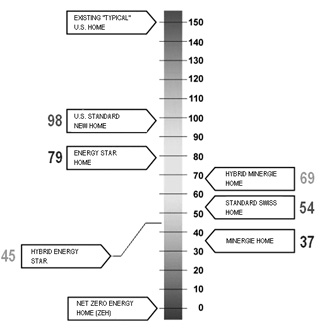
The standard U.S. home scored 98 with an improved score of 79 for the Energy Star home. In contrast, the Standard Swiss home scored a 54, whereas the low-energy (Minergie) version scored a 37. The Hybrid Minergie and Hybrid Energy Star homes scored a 69 and a 45, respectively. These numbers indicate that the mechanical systems in the Minergie home played a major role in reducing overall energy consumption. The impact of the Swiss building envelope was less important.
Payback Analysis
Estimates of energy consumption do not provide a complete picture of overall performance. An energy efficient home is not a worthwhile investment unless the utility costs are reduced by a corresponding amount over the life of the home. To calculate actual life cost analysis, an estimate of the construction costs of the six home models was conducted. Table 2 summarizes the costs for both construction and annual energy costs. The land is not included because it would be the same for each home category. The standard U.S. home has the lowest cost at $141,546, but it also has the highest energy costs $2,356. The Swiss Minergie home is more expensive ($164,013), but it would operate on an annual basis of only $1,242.
| Construction Category |
Construction Cost
($) |
Annual Energy Cost
($) |
|---|---|---|
| Standard U.S. | 141,546 | $2,356 |
| Energy Star | 144,848 | $2,088 |
| Standard Swiss | 161,932 | $1,838 |
| Minergie | 164,013 | $1,242 |
| Hybrid Energy Star | 152,148 | $1,475 |
| Hybrid Minergie | 156,713 | $2,095 |
Figure 5 summarizes the results of a payback analysis that considered the costs for the various housing options as a function of energy escalation rate. The vertical axis of the graph is the time period in years where various housing options are most economical. A discount rate of 1% was assumed for all computations. Only three of the six possible housing options appear in Figure 5, because those are the ones that achieved the highest savings.
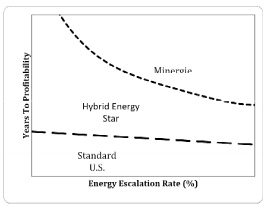
The Standard U.S. home would be the most cost effective option until year 13. The lower construction costs offset the larger energy expenditures for the first 13 years of home ownership. At that point, the Hybrid Energy Star would become cheaper and remain so until year 43. After year 43 the Minergie option would become the most cost-effective option. These examples show that more expensive and energy efficient housing options become attractive if energy rates increase sharply. As an extreme example, at a 10% annual energy escalation rate the more expensive Hybrid Energy Star home would become cost effective after 10 years. A Swiss-style Minergie home would be the best choice after 22 years.
Before the volatility of the real estate market began, people in the U.S tended to move frequently, so a home that is less expensive in terms of first cost is cost effective despite the higher energy costs. In contrast, a Swiss home is a once-in-a-lifetime investment, so it makes sense to invest in something that is cost effective over a much longer time period. It is also interesting that the Hybrid Energy Star option is cost effective between roughly 10 to 20 years of home ownership. This is the option that includes the building envelope of a U.S. Energy Star home with the mechanical systems of a Swiss Minergie home. This result shows that for this simplified analysis it was easier to justify the cost of improved mechanical systems as opposed to investing in a highly insulated building envelope.
Attitudes Toward Energy by Culture
Recognizing that technology by itself will not minimize energy consumption, a second part of the project explored cultural norms that influence energy use. A survey of U.S. and Swiss college students compared lifestyles and energy habits. Data was collected from students in comparable undergraduate thermodynamics classes at both a Midwestern U.S. university and a Swiss technical school. The survey included 58 U.S. students and 28 Swiss students. The difference in the size of the two student populations is directly related to the enrollment of the two academic programs.
The U.S. students were juniors; approximately 20 to 21 years of age, whereas the Swiss students were approximately 25 years old. The Swiss students were older because of a 4-year professional internship requirement before the formal academic training. This simple survey was not able to account for how differences in age and professional experience affect the results. One other potential flaw is that the survey was delivered in written English to both student populations. Although the Swiss students were generally fluent in both Swiss-German and English, there could be translation issues that the researchers were not aware of. The survey questions were kept simple, and visual cues were included on the survey form to make it easy to interpret. However, the survey did not specifically evaluate how proficiency in English affected the data.
Three broad areas were evaluated. One set of questions targeted basic expectations for housing in terms of size, style, cost, and so on. A second set of questions evaluated overall energy awareness and whether energy efficiency is an integral part of a student’s lifestyle. The third set of questions considered how energy awareness affected day-to-day decisions. The results of this brief survey revealed some substantial differences that begin to highlight how social norms can impact energy conservation.
The survey of Swiss and U.S. students included 21 questions. Many, but not all questions, were expressed as a 5-point Likert-type item. Table 4 is a sample of the survey results related to housing. These questions show how expectations for home ownership vary between Swiss and U.S. college students. The median age for achieving home ownership varied dramatically. Swiss students expected to buy their first home by age 35, whereas most U.S students expected to purchase their first home by age 25. Several Swiss students actually reported “never” in terms of home ownership, which supports the observation that long-term apartment living is relatively common in Switzerland.
Table 3 also shows that the student-reported median home price in Switzerland was $600,000, while the median was only $150,000 in the United States. As reported previously, the higher costs in Switzerland are driven by significantly different construction standards. A typical Swiss home is built for a design life of 100 years, much longer than one in the U.S. The striking cost difference is also in part because of the value of land in Lucerne, Switzerland, as compared to land in Midwestern United States. The Swiss culture dictates that a home is a significant once-in-a-lifetime investment, and homes are often passed down from one generation to the next. It makes good sense for the Swiss to wait until they are able to afford a substantial home purchase. In contrast, homes in the U.S. were a relatively short-term investment.
| Housing Options | Swiss | U.S. | ||
|---|---|---|---|---|
| Median | Mode | Median | Mode | |
| What age (years) do you expect to be when buying your first | 35 | 35 | 25 | 25 |
| What is your expected price for your first home? | $600,000 | $1,000,000 | $150,000 | $150,000 |
Table 4 is a sample of questions evaluating overall energy awareness. Students were queried about the importance of shutting off electrical appliances and recycling. For each question, students were asked to respond to a 5-point Likert-type item indexed from “not important” to “very important.” The goal of these survey questions was to discern whether students have a personal commitment toward sustainability.
| Energy Awareness | Category | ||||
|---|---|---|---|---|---|
| 1 | 2 | 3 | 4 | 5 | |
| How important is it to shut off your computer at night before going to bed? | Not Important | Not Interested | Neutral | Interested | Very Important |
| How important is it to you to recycle (e.g., Glass, Paper, or Plastic)? | Not Important | Not Interested | Neutral | Interested | Very Important |
The results shown in Table 4 illustrate some of the reported behavior patterns. Swiss students ranked the importance of turning off a computer much higher than their U.S. counterparts. The median value for Swiss students was 4, and the median value for U.S. students was 2.5. The two student populations responded in a similar way to the survey question that dealt with recycling. The rankings by both Swiss and U.S. students suggest that this topic has become part of the student culture. It has been observed that most U.S. students have grown up with recycling programs in their homes and schools.
| Energy Awareness | Swiss | U.S. | ||
|---|---|---|---|---|
| Median | Mode | Median | Mode | |
| How important is it to shut off your computer at night before going to bed? | 4 | 5 | 2.5 | 1 |
| How important is it to you to recycle (e.g., Glass, Paper, or Plastic)? | 4 | 4 | 3 | 4 |
Table 6 is a sample of the survey questions that evaluated the lifestyle impacts of energy conservation. The goal was to discern whether students make a conscious effort to engage in activities or behaviors that conserve energy. Rather than a scale in written English, emoticons were used. The simple facial expressions used in the survey and shown in Table 6 convey the same categorical information while avoiding the subtleties of written English.
| Lifestyle Impacts | Category | ||||
|---|---|---|---|---|---|
| 1 | 2 | 3 | 4 | 5 | |
| How willing would you be to walk 10 blocks during the winter or summer in order to save gasoline? |

|

|

|

|

|
| How happy would you be to not have air conditioning at all in your residence during the summer? |

|

|

|

|

|
Table 7 shows some results from the part of the survey that targeted lifestyle impacts. The first lifestyle question showed that Swiss students were more amenable to the prospect of walking 10 blocks (on the order of one mile) to save gas. The median and mode responses were a 4 for Swiss students and a 3 for U.S. students.
| Lifestyle Impacts | Swiss | U.S. | ||
|---|---|---|---|---|
| Median | Mode | Median | Mode | |
| How willingly would you be to walk 10 blocks during the winter or summer in order to save gasoline? | 4 | 4 | 3 | 3 |
| How happy would you be to not have air conditioning at all in your residence during the summer? | 4.5 | 5 | 2 | 1 |
The second lifestyle question explores the importance of air conditioning in the summer. Stark differences between Swiss and U.S. students were noted on this question. The median answer for Swiss students was a 4.5, which implies that summer air conditioning is not mandatory. The median response for their U.S. counterparts was a 2, meaning that summer air conditioning is an expectation for day-to-day living.
The air conditioning question reveals significant lifestyle differences. Many Swiss residences have a limited amount of air conditioning, due in part to a moderate climate noted in Table 1, but also because of differences in comfort expectations and regulations on residential electricity consumption. It is probably not a coincidence that many Swiss people take a month-long holiday in August, when apartment life without air conditioning could become very uncomfortable.
What is the overall message from this survey of Swiss and U.S. students? Is there an underlying theme that sheds light on differences in residential construction practices? An effort was made to consolidate the survey results by computing an “energy consciousness quotient.” This is an informal term that combines the three major survey topics (housing options, energy awareness, and resulting lifestyle impacts) in order to directly compare Swiss and U.S. students in terms of lifestyle differences that impact energy use.
The results of selected survey questions were combined into a scale with a range from 0 to 100%. The mean value for this “energy consciousness quotient” for the Swiss students was 85.5%, with a standard deviation of 0.51. The mean for U.S. students was 71%, with a standard deviation of 0.83. Statistics were applied to see whether the difference between the two values was statistically significant. T-statistic calculations showed with 99.9 % confidence Swiss students have a higher “energy consciousness quotient” than their U.S. counterparts.
The “energy consciousness quotient” is an interesting parameter. Within the population surveyed it probably does a reasonable job of quantifying to what extent energy conservation has an impact on student lifestyles. It was encouraging to document that both student populations consider energy conservation as part of day-to-day living. It is not surprising that Swiss students rated higher in this regard, probably because of simple economics. Costs for fuel, electricity, and other energy resources are typically higher in Switzerland.
Conclusions
This research analyzed six different residential construction models using Swiss and U.S. metrics. It was found that a Swiss home built in Indiana would be more expensive, yet more energy efficient than the other homes in its neighborhood. Typical U.S. construction techniques are cost effective during the short term. However, Swiss low energy construction becomes a better investment after longer periods of home ownership. A brief survey of students noted cultural, lifestyle, and economic differences that might also help explain the differences in construction standards.
Changes in energy policy and technology could affect some of the trends noted in this article. In the United States, federal tax credits for investments in residential energy efficiency, such as windows or insulation, have been popular. Future research could be completed utilizing this as a method to review possible zero-energy and energy efficiency techniques. European countries have more historic data that could be applied to the research of energy efficiency in the United States in the future.
Dr. Daphene Cyr Koch is an Assistant Professor in Building Construction Management at Purdue University in West Lafayette, Indiana.
William J. Hutzel is an Associate Professor of Mechanical Engineering Technology at Purdue University in West Lafayette, Indiana.
Jason M. Kutch was a graduate student in Mechanical Engineering Technology at Purdue University in West Lafayette, Indiana. He now works in facilities services at the university where he applies the energy developed from his research.
Eric A. Holt is a PhD graduate student of Building Construction Management at Purdue University in West Lafayette, Indiana.
References
Anderson, R., Christensen, C., & Horowitz, S. (2006). Analysis of residential system strategies targeting least-cost solutions leading to net zero energy homes. ASHRAE Transactions , 112 (Part 2), 330–341.
Banerjee, A., & Solomon, B. (2003). Eco-labeling for energy efficiency and sustainability: A meta-evaluation of US programs. Energy Policy . 31(2003). 109-123.
Charron, R., & Athieneitis, A. (2005). An international review of low and zero energy home initiatives . Paper presented at the ISES Solar World Congress 2005, Orlando, FL.
Energy Information Administration (EIA) (2010). International Energy Outlook 2010 (Report No. DOE/EIA-0484). Retrieved from http://www.eia.doe.gov/oiaf/ieo/
Energy Star (2009). Energy Star Qualified New Homes . Retrieved from http://www.energystar.gov/index.cfm?c=new_homes.hm_index
International Energy Agency (2008). Energy technologies perspectives: Scenarios and strategies to 2050, OECD/IEA , 2008, Paris.
Judkoff, R., & Neymark, J., (1995). Home energy rating system building energy simulation test (HERS BESTEST): Volume 1, Tier 1 and Tier 2 tests user's manual, Goldon, CO: National Renewable Energy Lab.
Minergie Homepage (2010). Retrieved from http://www.minergie.com
Polly, B., Gestwick, M., Bianchi, M., Anderson, R., Horowitz, S., Christensen, C., & Judkoff, R., (2011). A method of determining optimal residential energy efficiency retrofit packages. Goldon, CO: U.S. Department of Energy.
Perez-Lombard, L., Ortiz, J., & Pout, C., (2008). A review on buildings energy consumption information. Energy and Building 40(3) 394-398.
